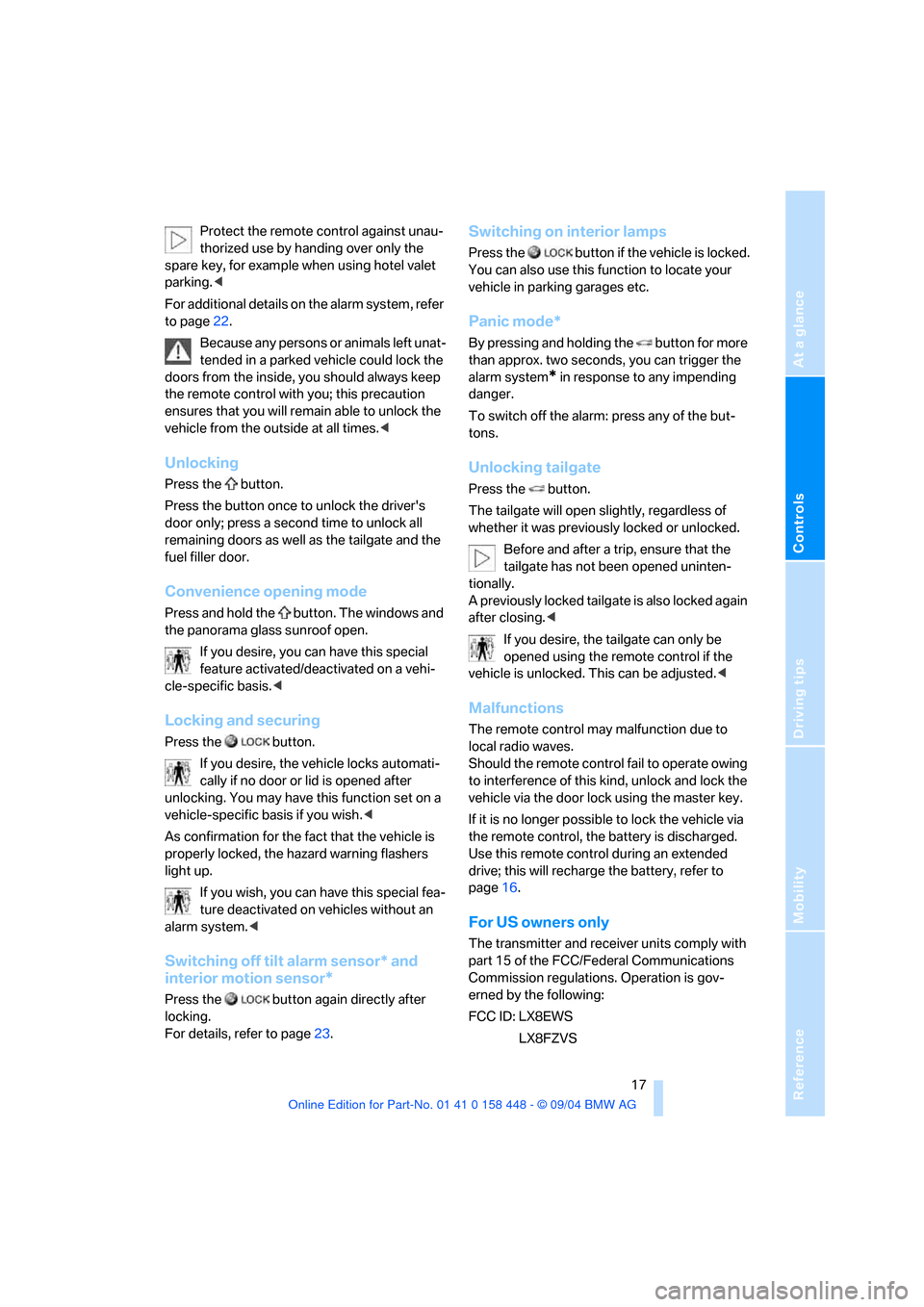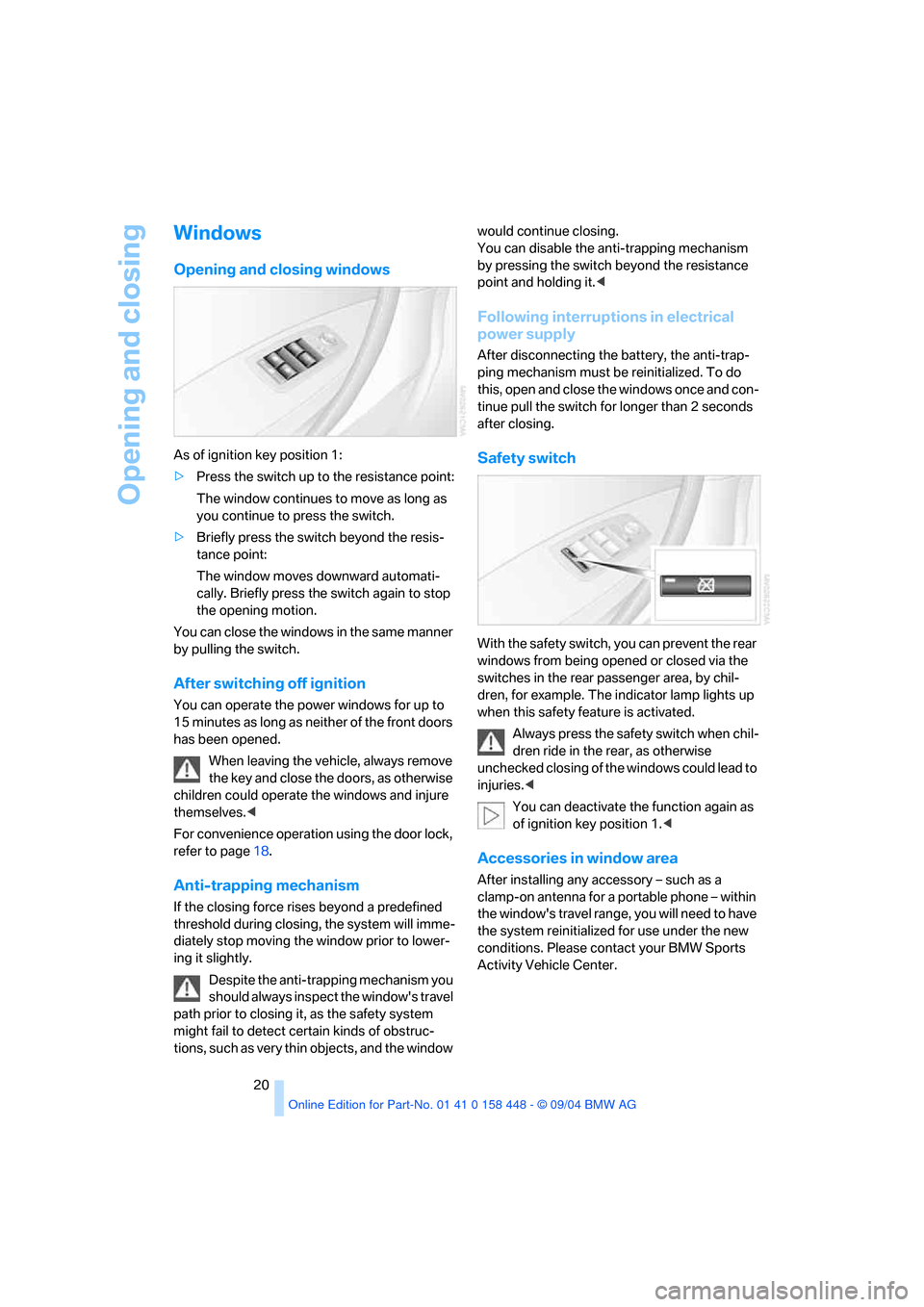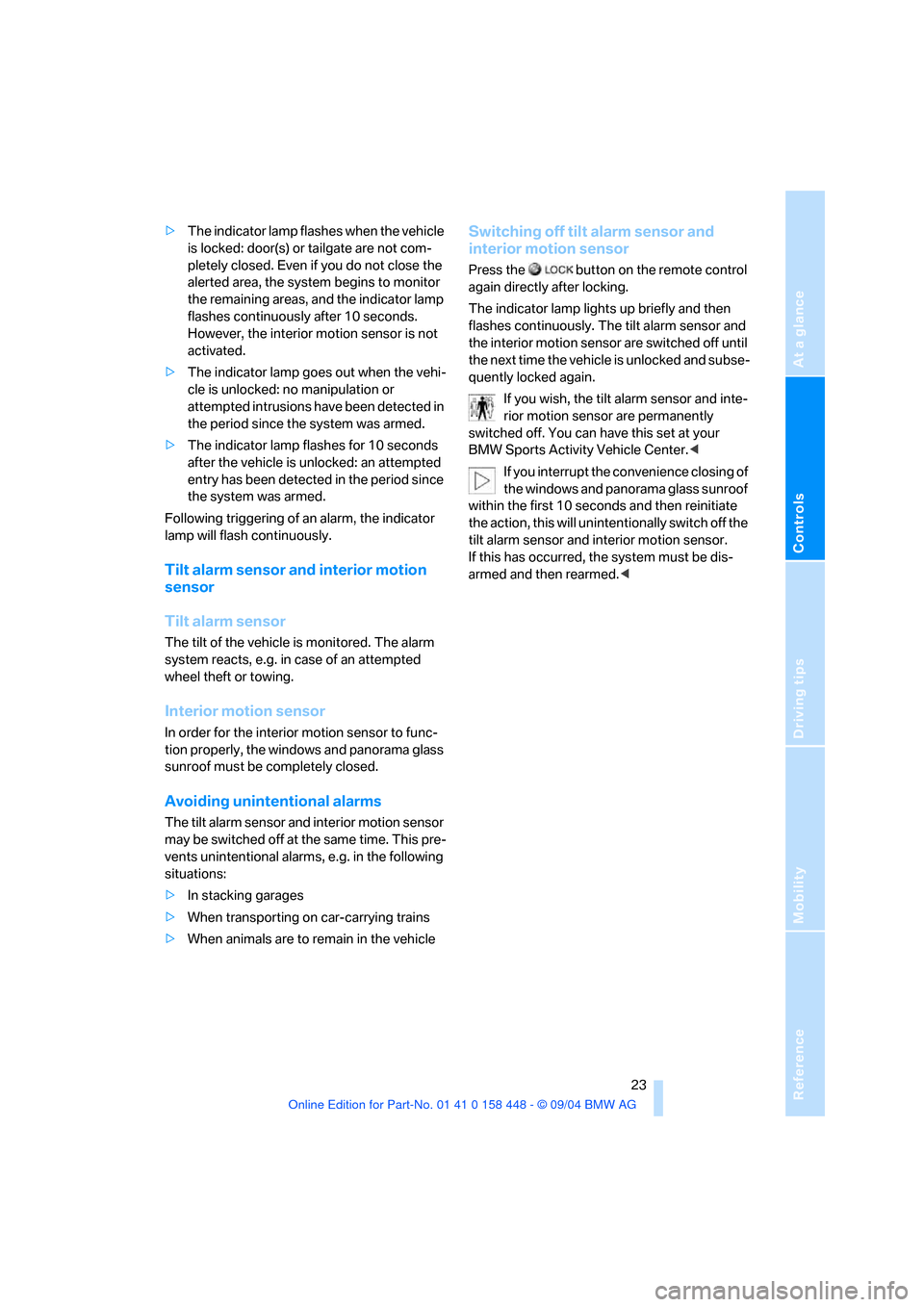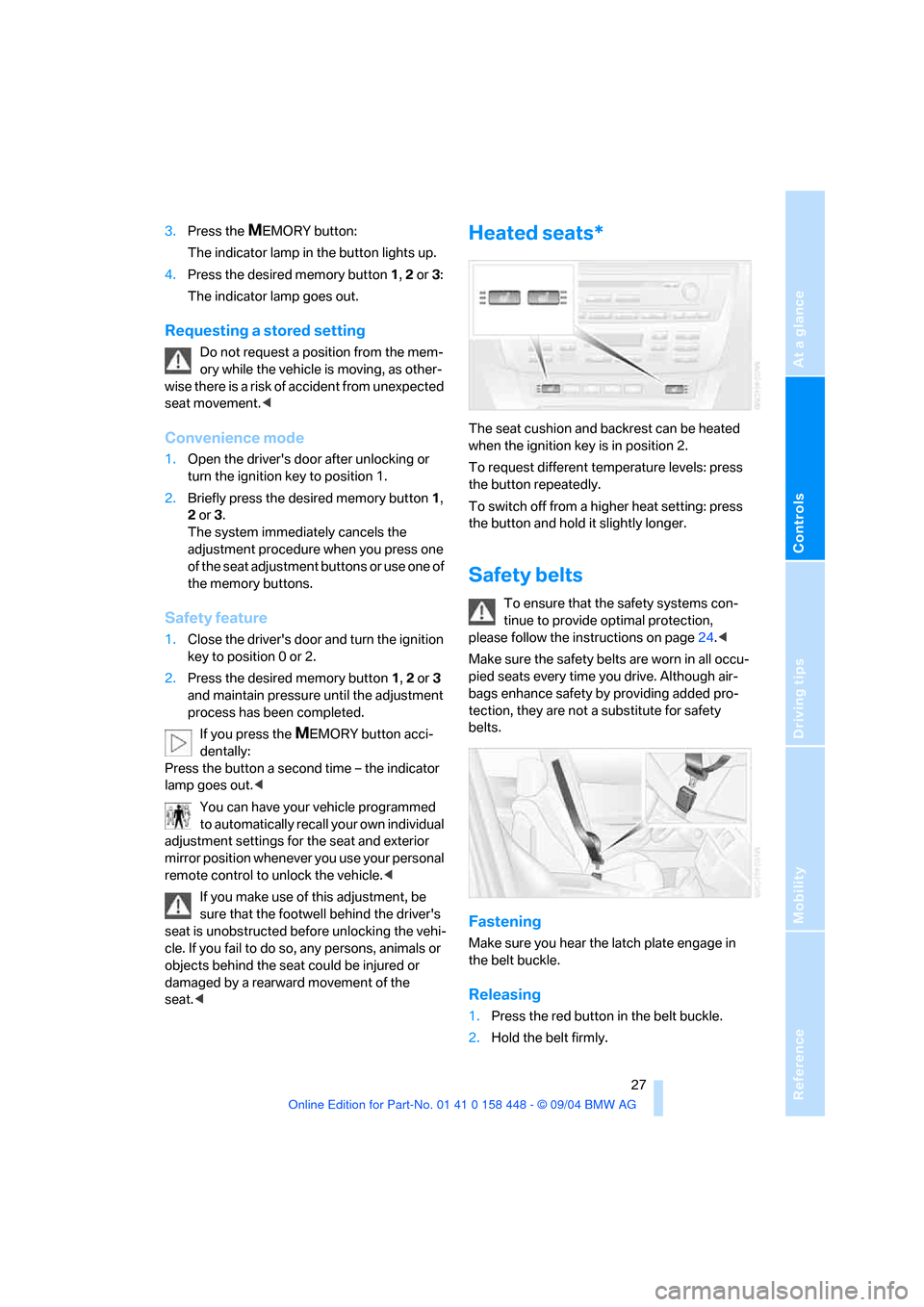door lock BMW X3 2.5I 2005 E83 Owner's Manual
[x] Cancel search | Manufacturer: BMW, Model Year: 2005, Model line: X3 2.5I, Model: BMW X3 2.5I 2005 E83Pages: 126, PDF Size: 4.65 MB
Page 13 of 126

Cockpit
12
Colors
The indicator and warning lamps can light up in
different colors and combinations.
The following section explains the significance
of the individual colors as well as how you
should respond when they appear.
>red:
Stop the vehicle immediately
or
an important reminder
>yellow:
Have the system inspected as soon as
possible
or
For your information
>green:
For your information
>blue:
For your information
Buttons on steering wheel*
The buttons integrated into the steering wheel
are provided so that you can operate a number
of accessories quickly and without being dis-
tracted from traffic conditions. You may oper-
ate:
>Selected audio source functions
>Recirculated-air mode/steering wheel
heater Brake warning lamp for Canadian
models
Driving stability control systems/
ABS Antilock Brake System
+49
ABS Antilock Brake System/chassis
control system for Canadian models
Brake pads
+92
DSC Dynamic Stability Control/
xDrive
+ 47, 49
Flat Tire Monitor
+49
Automatic transmission
+36
Engine oil
+90
Service Engine Soon
+94
Service Engine Soon warning lamp for
Canadian models
Check Gas Cap
* +80
Engine electronics
+34
Battery charge current
+101
Topping off coolant91
Topping off washer fluid90
Lamp defective53
Turn signals38
Front fog lamps54
Headlamp flasher38
High beams54
Cruise control40
Indicates from ignition key in posi-
tion 2 when a door or the tailgate is
opened.
Page 17 of 126

Opening and closing
16
Opening and closing
Key set
1Master keys with remote control
Every master key with remote control con-
tains an extended-life battery as a power
supply, which is charged automatically in
the ignition lock as you drive. You should
use each master key at least twice a year in
order to maintain the charge condition.
Depending on which master key is detected
by the vehicle during unlocking, different
settings in the vehicle are requested and
executed, refer to Vehicle and Key Memory
on page30.
2Spare key
For storage in a safe place, such as in your
wallet.
This key does not fit in the lock of the glove
compartment. This is an advantage, e.g.
when valet parking at a hotel. The key is not
intended for constant use.
Replacement keys
Replacement and additional keys are available
from your BMW Sport Activity Vehicle Center.
Central locking system
The concept
The central locking system is ready for opera-
tion whenever the driver's door is closed. The
system engages or releases the locks on the
>doors
>tailgate
>fuel filler door
The central locking system can be operated
from the outside
>via the remote control
>via the driver's door lock
and from inside via the button for the central
locking system.
When the system is locked from inside, the fuel
filler door remains unlocked, refer to page18.
The anti-theft system is automatically activated
whenever you activate the central locking sys-
tem from outside the vehicle. This prevents the
doors from being unlocked via the lock buttons
or door handles. The alarm system is also
armed or disarmed.
In the event of a serious accident, the central
locking system unlocks automatically. In addi-
tion, the hazard warning flashers and interior
lamps switch on.
Opening and closing: from
outside
Using the remote control
When you engage/release the vehicle locks,
you also activate/deactivate the anti-theft sys-
tem, arm/disarm
the alarm system, and switch
the interior lamps on/off.
You can set an acoustic signal to remind
you if the ignition key is still in the ignition
lock after you open the driver's door.<
Page 18 of 126

Reference
At a glance
Controls
Driving tips
Mobility
17
Protect the remote control against unau-
thorized use by handing over only the
spare key, for example when using hotel valet
parking.<
For additional details on the alarm system, refer
to page22.
Because any persons or animals left unat-
tended in a parked vehicle could lock the
doors from the inside, you should always keep
the remote control with you; this precaution
ensures that you will remain able to unlock the
vehicle from the outside at all times.<
Unlocking
Press the button.
Press the button once to unlock the driver's
door only; press a second time to unlock all
remaining doors as well as the tailgate and the
fuel filler door.
Convenience opening mode
Press and hold the button. The windows and
the panorama glass sunroof open.
If you desire, you can have this special
feature activated/deactivated on a vehi-
cle-specific basis.<
Locking and securing
Press the button.
If you desire, the vehicle locks automati-
cally if no door or lid is opened after
unlocking. You may have this function set on a
vehicle-specific basis if you wish.<
As confirmation for the fact that the vehicle is
properly locked, the hazard warning flashers
light up.
If you wish, you can have this special fea-
ture deactivated on vehicles without an
alarm system.<
Switching off tilt alarm sensor* and
interior motion sensor
*
Press the button again directly after
locking.
For details, refer to page23.
Switching on interior lamps
Press the button if the vehicle is locked.
You can also use this function to locate your
vehicle in parking garages etc.
Panic mode*
By pressing and holding the button for more
than approx. two seconds, you can trigger the
alarm system
* in response to any impending
danger.
To switch off the alarm: press any of the but-
tons.
Unlocking tailgate
Press the button.
The tailgate will open slightly, regardless of
whether it was previously locked or unlocked.
Before and after a trip, ensure that the
tailgate has not been opened uninten-
tionally.
A previously locked tailgate is also locked again
after closing.<
If you desire, the tailgate can only be
opened using the remote control if the
vehicle is unlocked. This can be adjusted.<
Malfunctions
The remote control may malfunction due to
local radio waves.
Should the remote control fail to operate owing
to interference of this kind, unlock and lock the
vehicle via the door lock using the master key.
If it is no longer possible to lock the vehicle via
the remote control, the battery is discharged.
Use this remote control during an extended
drive; this will recharge the battery, refer to
page16.
For US owners only
The transmitter and receiver units comply with
part 15 of the FCC/Federal Communications
Commission regulations. Operation is gov-
erned by the following:
FCC ID: LX8EWS
LX8FZVS
Page 19 of 126

Opening and closing
18 LX8FZVE
Compliance statement:
This device complies with part 15 of the FCC
Rules. Operation is subject to the following two
conditions:
>This device may not cause harmful interfer-
ence.
and
>This device must accept any interference
received, including interference that may
cause undesired operation.
Any unauthorized modifications or
changes to these devices could void the
user's authority to operate the equipment.<
Using door lock
One turn of the key in the driver's door lock
unlocks the driver's door only.
Turning the key a second time unlocks all of the
remaining doors, the tailgate and the fuel filler
door.
As confirmation for the fact that the vehicle is
properly locked, the hazard warning flashers
light up.
If you wish, you can have this special fea-
ture deactivated on vehicles without an
alarm system.<
Convenience operation
You also have the option of operating the win-
dows and the panorama glass sunroof from the
driver's door lock.
>To open:
With the door closed, turn the key to the
Unlock position and hold it there. >To close:
With the door closed, turn the key to the
Lock position and hold it.
Watch during the closing process to be
sure that no one is injured. Releasing the
key stops the operation.<
Manual operation
If an electrical malfunction occurs, you can
unlock or lock the driver's door with the key in
the end positions of the door lock.
Opening and closing: from
inside
You can use this button to operate the central
locking system when the front doors are closed.
With this button, only the doors and the tailgate
are unlocked or locked. The anti-theft system is
not activated.
If only the driver's door was unlocked
from the outside and you press the but-
ton, then, with the driver's door still open, the
passenger-side door, the tailgate and the fuel
filler door will also unlock.
If the driver's door is closed, it will be locked.<
The central locking system locks auto-
matically after driving off. This can be
adjusted to be vehicle-specific or key-spe-
cific.<
Page 20 of 126

Reference
At a glance
Controls
Driving tips
Mobility
19
Unlocking and opening doors
1.Press button for central locking system.
2.Pull the respective door handle above the
armrest.
or
individually pull on the door handle of each door
twice to unlock and open.
Engaging locks
>Press button for central locking system.
or
>Press down the lock buttons of the doors.
To prevent you from being locked out, the
opened driver's door cannot be locked
using the lock button.
Because any persons or animals left unat-
tended in a parked vehicle could lock the
doors from the inside, you should always keep
the key with you; this precaution ensures that
you will remain able to unlock the vehicle from
the outside at all times.<
Tailgate
Opening from outside
Press the button in the handle strip. The tailgate
is unlocked and opens somewhat.
During opening, the tailgate pivots back
and up. Ensure that adequate clearance is
available before opening.<
When the tailgate is open, the cargo area and
interior are lit up.
Manual unlocking
In the event of an electrical malfunction:
1.Fold up the floor cover in the cargo area.
2.Release the jack from the bracket.
3.Press the lever behind the cover to the side,
refer to arrow.
The tailgate is locked again as soon as you
close it.
Closing
The handle recesses on the interior trim of the
tailgate make it easier to pull down.
To avoid injuries, be sure that the travel
path of the tailgate is clear when it is
closed, as with all closing procedures.<
Page 21 of 126

Opening and closing
20
Windows
Opening and closing windows
As of ignition key position 1:
>Press the switch up to the resistance point:
The window continues to move as long as
you continue to press the switch.
>Briefly press the switch beyond the resis-
tance point:
The window moves downward automati-
cally. Briefly press the switch again to stop
the opening motion.
You can close the windows in the same manner
by pulling the switch.
After switching off ignition
You can operate the power windows for up to
15 minutes as long as neither of the front doors
has been opened.
When leaving the vehicle, always remove
the key and close the doors, as otherwise
children could operate the windows and injure
themselves.<
For convenience operation using the door lock,
refer to page18.
Anti-trapping mechanism
If the closing force rises beyond a predefined
threshold during closing, the system will imme-
diately stop moving the window prior to lower-
ing it slightly.
Despite the anti-trapping mechanism you
should always inspect the window's travel
path prior to closing it, as the safety system
might fail to detect certain kinds of obstruc-
tions, such as very thin objects, and the window would continue closing.
You can disable the anti-trapping mechanism
by pressing the switch beyond the resistance
point and holding it.<
Following interruptions in electrical
power supply
After disconnecting the battery, the anti-trap-
ping mechanism must be reinitialized. To do
this, open and close the windows once and con-
tinue pull the switch for longer than 2 seconds
after closing.
Safety switch
With the safety switch, you can prevent the rear
windows from being opened or closed via the
switches in the rear passenger area, by chil-
dren, for example. The indicator lamp lights up
when this safety feature is activated.
Always press the safety switch when chil-
dren ride in the rear, as otherwise
unchecked closing of the windows could lead to
injuries.<
You can deactivate the function again as
of ignition key position 1.<
Accessories in window area
After installing any accessory – such as a
clamp-on antenna for a portable phone – within
the window's travel range, you will need to have
the system reinitialized for use under the new
conditions. Please contact your BMW Sports
Activity Vehicle Center.
Page 23 of 126

Opening and closing
22
Manual operation
In the event of an electrical malfunction, you can
operate the panorama glass sunroof manually.
1.Pull off the cover firmly downward.
2.Insert the Allen wrench from the compart-
ment beneath the cargo area floor, refer to
page99, into the proper opening and turn
the panorama glass sunroof in the desired
direction. Direction of rotation for closing,
refer to arrow.
Alarm system*
The concept
The vehicle alarm system responds:
>When a door, the hood, or the tailgate is
opened.
>To movements inside the vehicle: interior
motion sensor, refer to Tilt alarm sensor
and interior motion sensor.
>To changes in the vehicle tilt angle such as
occur during attempts to steal the wheels or
tow the vehicle.
>To interruptions in battery voltage.The system responds to unauthorized vehicle
entry and attempted theft by simultaneously
activating:
>The acoustic alarm for approx. 30 seconds.
>The hazard warning flashers for approx.
5minutes.
>The high beams, which flash on and off in
the same rhythm.
Arming and disarming alarm system
When you lock or unlock the vehicle, either with
the remote control or at the door lock, the alarm
system is armed or disarmed at the same time.
If the alarm system has been properly armed,
the hazard warning flashers light up once.
You can have different acknowledgment
signals set to confirm arming and disarm-
ing.<
You can also open the tailgate with the system
armed using the button on the remote con-
trol, refer to page17. When you close the tail-
gate, the system is rearmed.
Switching off alarm
>Unlock the vehicle using the remote control,
refer to page17.
or
>Turn the ignition key to position 1.
Indicator lamp displays
>The indicator lamp below the interior rear-
view mirror flashes continuously: the sys-
tem is armed.
Page 24 of 126

Reference
At a glance
Controls
Driving tips
Mobility
23
>The indicator lamp flashes when the vehicle
is locked: door(s) or tailgate are not com-
pletely closed. Even if you do not close the
alerted area, the system begins to monitor
the remaining areas, and the indicator lamp
flashes continuously after 10 seconds.
However, the interior motion sensor is not
activated.
>The indicator lamp goes out when the vehi-
cle is unlocked: no manipulation or
attempted intrusions have been detected in
the period since the system was armed.
>The indicator lamp flashes for 10 seconds
after the vehicle is unlocked: an attempted
entry has been detected in the period since
the system was armed.
Following triggering of an alarm, the indicator
lamp will flash continuously.
Tilt alarm sensor and interior motion
sensor
Tilt alarm sensor
The tilt of the vehicle is monitored. The alarm
system reacts, e.g. in case of an attempted
wheel theft or towing.
Interior motion sensor
In order for the interior motion sensor to func-
tion properly, the windows and panorama glass
sunroof must be completely closed.
Avoiding unintentional alarms
The tilt alarm sensor and interior motion sensor
may be switched off at the same time. This pre-
vents unintentional alarms, e.g. in the following
situations:
>In stacking garages
>When transporting on car-carrying trains
>When animals are to remain in the vehicle
Switching off tilt alarm sensor and
interior motion sensor
Press the button on the remote control
again directly after locking.
The indicator lamp lights up briefly and then
flashes continuously. The tilt alarm sensor and
the interior motion sensor are switched off until
the next time the vehicle is unlocked and subse-
quently locked again.
If you wish, the tilt alarm sensor and inte-
rior motion sensor are permanently
switched off. You can have this set at your
BMW Sports Activity Vehicle Center.<
If you interrupt the convenience closing of
the windows and panorama glass sunroof
within the first 10 seconds and then reinitiate
the action, this will unintentionally switch off the
tilt alarm sensor and interior motion sensor.
If this has occurred, the system must be dis-
armed and then rearmed.<
Page 28 of 126

Reference
At a glance
Controls
Driving tips
Mobility
27
3.Press the MEMORY button:
The indicator lamp in the button lights up.
4.Press the desired memory button 1, 2 or3:
The indicator lamp goes out.
Requesting a stored setting
Do not request a position from the mem-
ory while the vehicle is moving, as other-
wise there is a risk of accident from unexpected
seat movement.<
Convenience mode
1.Open the driver's door after unlocking or
turn the ignition key to position 1.
2.Briefly press the desired memory button 1,
2 or3.
The system immediately cancels the
adjustment procedure when you press one
of the seat adjustment buttons or use one of
the memory buttons.
Safety feature
1.Close the driver's door and turn the ignition
key to position 0 or 2.
2.Press the desired memory button 1, 2 or3
and maintain pressure until the adjustment
process has been completed.
If you press the
MEMORY button acci-
dentally:
Press the button a second time – the indicator
lamp goes out.<
You can have your vehicle programmed
to automatically recall your own individual
adjustment settings for the seat and exterior
mirror position whenever you use your personal
remote control to unlock the vehicle.<
If you make use of this adjustment, be
sure that the footwell behind the driver's
seat is unobstructed before unlocking the vehi-
cle. If you fail to do so, any persons, animals or
objects behind the seat could be injured or
damaged by a rearward movement of the
seat.<
Heated seats*
The seat cushion and backrest can be heated
when the ignition key is in position 2.
To request different temperature levels: press
the button repeatedly.
To switch off from a higher heat setting: press
the button and hold it slightly longer.
Safety belts
To ensure that the safety systems con-
tinue to provide optimal protection,
please follow the instructions on page24.<
Make sure the safety belts are worn in all occu-
pied seats every time you drive. Although air-
bags enhance safety by providing added pro-
tection, they are not a substitute for safety
belts.
Fastening
Make sure you hear the latch plate engage in
the belt buckle.
Releasing
1.Press the red button in the belt buckle.
2.Hold the belt firmly.
Page 31 of 126

Adjustments
30
Vehicle Memory, Key Memory
How the system functions
You have probably frequently wished that you
could configure individual functions of your
vehicle to reflect your own personal require-
ments. In developing your vehicle, BMW has
incorporated a number of options for personal
adjustment. You can have these programmed
at your BMW Sports Activity Vehicle Center.
There are vehicle-related and person-related
adjustments: Vehicle Memory and Key Mem-
ory. You can configure up to four different basic
adjustments for four different persons. The only
requirement is that each person uses his or her
own master key with remote control.
When your vehicle is unlocked with the remote
control, the vehicle recognizes the individual
user by means of a data exchange with the key,
and makes adjustments accordingly.
In order for you to distinguish between the mas-
ter keys with remote control, color-coded
decals are supplied together with the keys.
What the system can do
Your BMW Sports Activity Vehicle Center can
provide you with details on the capabilities of
the Vehicle Memory and Key Memory systems.
You will see this symbol throughout the
Owner's Manual. It is to remind you at
appropriate places of the settings that are avail-
able to you.<
Following configuration of memory func-
tions, vehicle operation may differ from
the description in the Owner's Manual. Should
you want to sell your BMW some day, please
remember to have the memory functions reset
to the factory default settings.<
Examples of Vehicle Memory functions
>Different acknowledgment signals to con-
firm locking/unlocking of the vehicle, refer
to page16.
>Activating/deactivating function for path-
way lighting, refer to page53.
>Activating/deactivating daytime driving
lamps, refer to page53.
>Setting measurement units for displays in
the instrument cluster for time, outside
temperature, distance driven and fuel con-
sumption, refer to page44.
>Active PDC Park Distance Control is indi-
cated by an acoustic sound signal when
reverse gear or selector lever position R is
engaged, refer to page46.
>The rear window defroster switches on
automatically, refer to page57.
>Different acknowledgment signals to con-
firm arming/disarming the alarm system,
refer to page22.
>After an ice warning has been issued, the
computer display returns to the previous
adjustment, refer to page44.
>Acoustic warning if the ignition key remains
in the ignition lock after the driver's door has
been opened, refer to page19.
Examples of Key Memory functions
>When unlocking, first unlock the driver's
door, then the entire vehicle, refer to
page17.
>Locking the vehicle after moving off, refer to
page18.
>Automatic adjustment of the driver's seat
and exterior mirror position for each person
when unlocking the vehicle, refer to
page27.
>Angle of downward tilt of mirror on passen-
ger side, refer to page29.